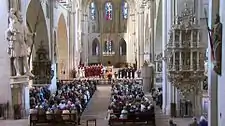Santini's Network
Santini's Network (original title: La Rete di Santini) (2014) is a biographical film by German filmmaker Georg Brintrup on the life of Roman music collector Fortunato Santini (1777–1861) and how his famous private assembly of manuscript scores grew into the greatest music collection of the age.
| Santini’s Network | |
|---|---|
 filmset in the Cathedral Church of Saint Paul | |
| Directed by | Georg Brintrup |
| Produced by | Lichtspiel Entertainment Wulf-Ernst Hoffer Westdeutscher Rundfunk |
| Written by | Georg Brintrup Mario Di Desidero |
| Starring | Renato Scarpa |
| Cinematography | Benjamin Hasenclever Marco Leopardi Diego D'Innocenzo Dieter Fietzke Alessandro Iafulla Valerio Cesaroni |
| Edited by | Georg Brintrup |
Release date | April 9, 2014 |
Running time | 85 minutes |
| Country | Italy / Germany |
| Language | Italian, German, English |
Plot
The subject portrays an extraordinary story and a fascinating itinerary of survival through unusual episodes in the progress of culture. When, at the turn of the eighteenth century, the Roman clergyman, Fortunato Santini, played by Italian actor Renato Scarpa, discovers at the age of twenty his fervent passion for music, he decides to dedicate the rest of his life to collecting the manuscript scores of the great composers, either autographs in their own hand or scores written out by professional copyists. These manuscripts kept and preserved the heritage of musical works until their reproduction and publication as printed scores. Over the course of fifty years his music collection swelled to 20,000 titles in 4,500 manuscripts and 1,200 printed copies, making it the most comprehensive collection of its kind anywhere.[1] Santini's secret in preserving all these important works from the history of European music is the elaborate network of friends and acquaintances that he builds. Beginning in the libraries and among the cognoscenti of Italy, its reach extends throughout Europe, stretching from Rome to Vienna, from Paris to London, from Berlin to Moscow. Through his networking skills during his lifetime Santini became an international celebrity in the world of music Compositions of the first importance in music history, otherwise at risk of disappearing into oblivion, were rescued and preserved through his unremitting efforts.
The film deals not only with the inception and growth of Santini's precious collection, but also with its conservation after his death. In 1862 the collection was purchased and transported from Italy to the city of Münster in Germany and lay there forgotten for 40 years. Then in 1902 this trove was rediscovered and brought to the attention of the public through by the work of Edward Dent, the distinguished British musicologist. Subsequently, the collection was saved from firebombs during World War II , and though partially damaged after the war by a devastating flood, the irreplaceable musical opus of Santini has survived.
Cast
- Renato Scarpa: Fortunato Santini
- John Gayford: Edward Dent
- Maximilian Scheidt: Felix Mendelssohn
- Harald Redmer: Carl Friedrich Zelter
- Domenico Galasso: Giuseppe Baini
- Claudio Marchione: Giuseppe Jannacconi
- Pietro M. Beccatini: Carlo Odescalchi
- Antonio Giovannini: Mariano Astolfi
- Florian Steffens: young Edward Dent
- Emanuele Paragallo: young Fortunato Santini
Film music
The Soundtrack is composed of musical pieces from Santini's collection, some performed for the first time under conductor Favio Colusso by the Ensemble Seicentonovecento.
| Nr. | Author | Titel |
|---|---|---|
| 1. | Antonio Lotti | Crucifixus |
| 2. | Tomás Luis de Victoria | Salve Regina |
| 3. | Cristóbal de Morales | Lamentabatur Jacob |
| 4. | Giacomo Carissimi | Jephte, Plorate filii Israel |
| 5. | Antonio Caldara | Kyrie from the Missa Dolorosa |
| 6. | Francesco Durante | Lamentationes Jeremiae Prophetae |
| 7. | Palestrina | Kyrie from the Missa Ut-Re-Mi-Fa-So-La |
| 8. | Giovanni Battista Martini | Sonata g-minor for Organ, Sarabanda |
| 9. | Palestrina | Aleph III |
| 10. | Carl Heinrich Graun | Der Tod Jesu |
| 11. | Georg Friedrich Händel | Non esce un guardo mai |
| 12. | Georg Friedrich Händel | Resurrezione |
| 13. | Alessandro Melani | Magnificat |
| 14. | Johann Sebastian Bach | Passio secundum Joannem |
| 15. | Fortunato Santini | Te Deum a Due Cori |
| 16. | Domenico Scarlatti | Sonatas in f-Minor K. 519 |
| 17. | Francesco Durante | Requiem Lacrimosa |
| 18. | Alessandro Scarlatti | Agar et Ismaele esiliati, grave |
| 19. | Domenico Scarlatti | sonata in f-Minor L.281 K.239 |
| 20. | Georg Friedrich Händel | Israel in Egypt / a thick darkness |
| 21. | Fortunato Santini | Sancte Paule Apostole |
Some other background music was composed by Flavio Colusso.
Release and reception
Santini’s Network premiered at the Auditorium of Santa Maria dell’Anima in Rome on 1 April 2014 [2] and in Münster's Schloßtheater on 9 April 2014.[3] Film critic Günter Moseler: "A great film about a modest life for the future of Early Music." (Ein großer Film über ein kleines Leben für die Zukunft Alter Musik.).[4] First broadcast was in Westdeutscher Rundfunk on 28 April 2014.
References
- Peter Schmitz and Andrea Ammendola (editors): Sammeln – Komponieren – Bearbeiten. Der römische Abbate Fortunato Santini im Spiegel seines Schaffens [Catalog of the Fortunato Santini exhibition in Münster, from September 15 to December 31, 2011], Münster 2011
- "La Via dell’Anima" Tesori musicali da Roma a Münster, 2014 (pdf)
- http://www.muenster.org/filmwerkstatt/2014/03/santinis-netzwerk-von-georg-brintrup.html
- "Verrückt nach Musik" (Crazy for Music) in Münstersche Zeitung on April 11, 2014